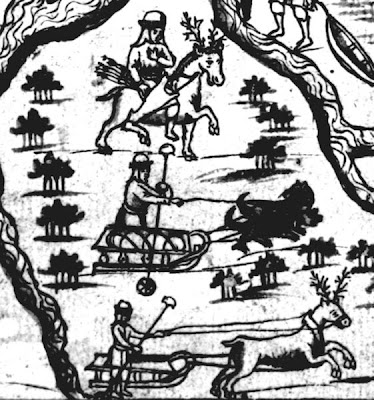Of course Brent is also a distributor of Dr. Tim's Momentum dog-food. Yesterday I needed to stock up on kibble, so I made an appointment to pick up the food yesterday evening. While I was waiting for Brent, who had just finished the last tour group of the season, I spied a very interesting traditional freight sled sitting in the yard. With my new camera readily at hand, I couldn't resist the opportunity to capture a few pictures of the sled.
I've recently been doing some historical research to learn more about the development and evolution of these massive cargo haulers, and some were massive indeed. Brent's sled is easily 12 feet long or perhaps a bit longer. Although he doesn't know the exact weight of the sled, it is certainly not a light-weight piece of equipment. It's hard work to just lift one end of it off the ground. Brent reported that in the past he has hauled more than a 1/2 ton of cargo on that sled while mushing on the North Slope.
The best available evidence I've found thus far hints that the Alaskan freight sled evolved from a sled originally developed by Native mushers in Siberia. The basic construction method is identical to the Siberian "Narta". The earliest image I've found of a Siberian sled is from a woodcut published in a book from the late 17th century.
 |
| Narta images from Remezov Chronical, late 18th century |
There was a very active trade between Alaskan Native and Siberian Native peoples long before the Russians laid claim to Alaska, let alone ventured beyond her coastline. It is quite likely that the Siberian "Narta" sled was introduced to Alaskan Natives by their trading partners from across Bering's Sea.
When Americans first visited the northwestern coast and Yukon River drainage of Alaska, Russian fur traders and their Native trading partners were using a very similar sled. In 1865 the Western Union Telegraph Company began exploring routes in Alaska and Siberia with the goal of laying a telegraph line between the United States and Europe, via Moscow. Among those early expolorers was artist Frederick Whymper. Mr. Whymper left a detailed account of his own explorations on the Alaskan side, including the first up-river trip between Nulato and the Hudson's Bay Company trading post of Fort Yukon, thus filling in a considerable gap in the maps of the day.
Among the treasures found in Whymper's book Travel and Adventure in the Territory of Alaska is an image of a sketch he drew of Russian traders loading their narta for a trip from Saint Michaels to Nulato.
 |
| Whymper's sketch ca about 1866 or 1877 |
When America purchased Alaska in 1868, it didn't take long for trade and travel patterns to change. In July of 1868 the steamer Yukon traveled the river to the HBC post of Fort Yukon where U.S. Army Captain Charles P. Raymond confirmed the post was on American soil, and politely asked the British owned firm to get the hell out. In his report Raymond wrote "The Stars and Stripes now float at Fort Yukon. Anyone who desires to is at liberty to look for mines."
In those earliest years, economic activity in the Interior was primarily based on the fur-trade, though some prospectors were already making their way inland. Those early American traders initially took over posts previously owned by the Russian American company, and apparently adopted Russian and Native dog mushing methods and equipment as well.
By the time of the Klondike Gold Rush, the basket style freight sled had evolved very little, as can be seen in an image drawn by Tappan Adney during the winter of 1897 - 98.
 |
| Sketched by Tappan Adney at Klondike City, winter of 1897 - '98 |
This brings us full circle back to Brent's freight sled. My first impression when looking at the profile (sideways) view is this darned thing is HUGE compared to traveling sleds, let alone to very light weight sleds designed primarily for racing.
 |
| Brent Sass' freight sled, profile view. |
I'm thinking a fellow could haul a heck of a lot of dog food on a sled such as that, but it certainly isn't going to be easy trying to maneuver it on a twisty trail through the woods.
Historical References:
Remezov Chronicles
Whymper, Frederick: Travel and Adventure in the Territory of Alaska; John Murray; London; 1868.
Adney, Tappan; The Klondyke Stampede; Harper and Brothers Publishers; New York & London, 1900.

No comments:
Post a Comment